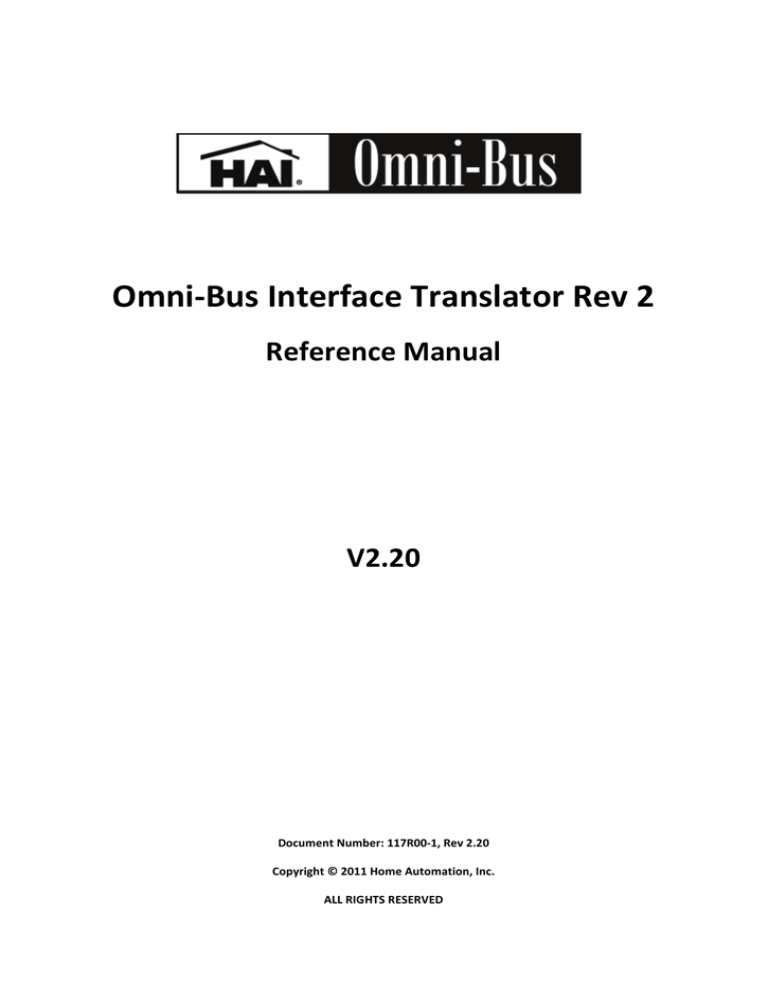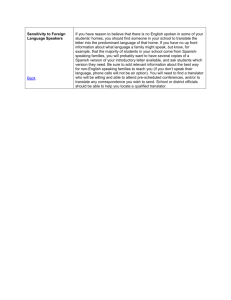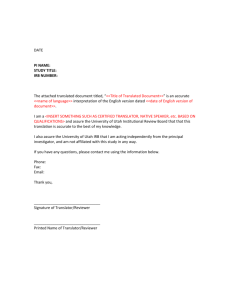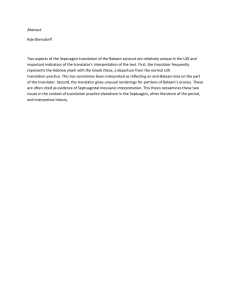
®
Omni-Bus Interface Translator Rev 2
Reference Manual
V2.20
Document Number: 117R00-1, Rev 2.20
Copyright © 2011 Home Automation, Inc.
ALL RIGHTS RESERVED
Omni-Bus Interface Translator Reference Manual
Table of Contents
1.
Overview ................................................................................................................................................................... 3
1.1.
HAI Omni-Link Interface .................................................................................................................................... 3
1.2.
Bus Gateway ..................................................................................................................................................... 4
2.
TCPIP Network Setup ................................................................................................................................................ 5
3.
USB Gateway Setup................................................................................................................................................... 6
4.
TCPIP Gateway Setup ................................................................................................................................................ 7
4.1.
Enabling the TCPIP Gateway ............................................................................................................................. 7
4.2.
Connecting to the TCPIP Gateway from OMNIBUS .......................................................................................... 8
4.3.
Using the TCPIP Gateway .................................................................................................................................. 8
5.
HAI Omni-Link Interface Setup.................................................................................................................................. 9
5.1.
Enabling the HAI Omni-Link RS232 Interface .................................................................................................... 9
5.2.
Enabling the HAI Omni-Link TCPIP Interface..................................................................................................... 9
5.3.
RS232 Interface Setup ..................................................................................................................................... 10
5.4.
TCPIP Interface Setup...................................................................................................................................... 11
6.
Device Setup ........................................................................................................................................................... 12
6.1.
OMNIBUS Device Setup – Bus Devices – Method 1 ........................................................................................ 12
6.2.
OMNIBUS Device Setup – Bus Devices – Method 2 ........................................................................................ 13
6.3.
OMNIBUS Device Setup – RF Devices ............................................................................................................. 14
7.
HAI Omni Controller Setup...................................................................................................................................... 15
7.1.
RS232 Interface ............................................................................................................................................... 15
7.2.
TCPIP Interface ................................................................................................................................................ 16
7.3.
Unit Setup ....................................................................................................................................................... 16
8.
Diagnostics .............................................................................................................................................................. 17
8.1.
Fatal Error Audio report .................................................................................................................................. 17
8.2.
Non-Fatal Error Audio report .......................................................................................................................... 18
8.3.
General Audio reporting ................................................................................................................................. 18
9.
Firmware Upgrade .................................................................................................................................................. 19
10.
Hardware Connections........................................................................................................................................ 20
11.
Omni-Link Serial Interface Cable Pinout ............................................................................................................. 21
Page 2 of 21
© 2011 Home Automation, Inc.
ALL RIGHTS RESERVED
Document: 117R00-1
Rev 2.20
Omni-Bus Interface Translator Reference Manual
Note: For the purpose of this document it is assumed that the user is familiar with the general programming and setup
procedures of the HAI and Omni-Bus systems. Please refer to the relevant documentation for more information.
This setup procedure requires OMNIBUS SOFTWARE V1.0.2 or newer and Interface Translator Hardware Rev 2
(117A00-1 Rev 2) with firmware release V2.20 or later.
Please visit www.homeauto.com to download the latest OMNIBUS software.
1. Overview
1.1. HAI Omni-Link Interface
The Omni-Bus Interface (Translator) hardware communicates with the HAI controller via a RS232 serial
connection or a TCPIP network connection.
Option 1: RS232
Option 2: TCPIP
LOCAL AREA NETWORK
(ETHERNET)
RS232
INTERFACE
TRANSLATOR
INTERFACE
TRANSLATOR
117A00-1
117A00-1
OMNIBUS NETWORK
OMNIBUS NETWORK
HAI CONTROLLER
HAI CONTROLLER
The interface operates by creating a relationship between the Omni-Bus products and the HAI Controller. This
relationship between the two products is achieved by cross referencing the serial number of the Omni-Bus
product to an address number that correlates to the same address or unit number on the HAI Controller.
Addresses on the Omni-Bus system are assigned to each Omni-Bus Device using the OMNIBUS software.
Page 3 of 21
© 2011 Home Automation, Inc.
ALL RIGHTS RESERVED
Document: 117R00-1
Rev 2.20
Omni-Bus Interface Translator Reference Manual
1.2. Bus Gateway
The Omni-Bus Interface Translator can be utilized as a Gateway between the HAI OMNIBUS software and a
Omni-Bus Bus Network utilizing a local area Ethernet network or USB connection.
The USB and TCPIP Bus Gateway functions can be used simultaneously with the HAI Omni-Link Interface.
1.2.1. USB Bus Gateway
INTERFACE
TRANSLATOR
117A00-1
USB CABLE
OMNIBUS NETWORK
OMNIBUS
Installation
Software
1.2.2. TCPIP Bus Gateway
LOCAL AREA NETWORK
(ETHERNET)
INTERFACE
TRANSLATOR
117A00-1
OMNIBUS NETWORK
Page 4 of 21
© 2011 Home Automation, Inc.
ALL RIGHTS RESERVED
OMNIBUS
Installation
Software
Document: 117R00-1
Rev 2.20
Omni-Bus Interface Translator Reference Manual
2. TCPIP Network Setup
•
•
•
•
In OMNIBUS, go to the Interface Translator setup form (double click on the Translator after a List
Devices)
Set the Translator Ethernet network settings for the local network by clicking on the Network Setup Tab
(consult your network administrator to obtain the necessary TCPIP network settings for the Interface
Translator)
o Ethernet Port Enabled: Enable or disable the ethernet port on the translator.
o Optain an IP Address Automatically: Select to get an IP address for the Translator from the
DHCP server on the network.
o Use the following IP Address: Select to set a fixed IP address for the Translator.
o IP Address: Fixed IP address that will be used by the Translator to connect to the local network.
This is also the Bus gateway address that will used by OMNIBUS to connect to the Translator in
TCPIP Communication mode.
o Subnet Mask: Network subnet mask.
o Default Gateway: Network gateway.
o TCP Port Number: The Bus Gateway port number used by OMNIBUS.
o Password: Used by OMNIBUS when connecting to the Translator in TCPIP Communication
mode.
In DHCP mode, the IP address assigned to the Translator by the DHCP server will be displayed at the
bottom of the Network Setup screen.
To restore the network settings to the factory default values:
o Unplug the Translator from the Bus network or external power supply.
o While pressing and holding the button at the bottom of the unit, restore power to the Translator.
o Keep the button pressed in until the Translator sounds 3 beeps (after approximately 10 seconds).
Release the button. The Translator will automatically restart with the following default settings:
Ethernet Port: Enabled
Optain an IP Address Automatically: Enabled
Fixed IP: Disabled
TCP Port Number: 43690
Password: Enabled
Code: 1234
Page 5 of 21
© 2011 Home Automation, Inc.
ALL RIGHTS RESERVED
Document: 117R00-1
Rev 2.20
Omni-Bus Interface Translator Reference Manual
3. USB Gateway Setup
•
•
•
•
•
•
•
•
Page 6 of 21
The USB Gateway is always active (enabled) on the Interface Translator. No further setup procedure is
required on the Interface Translator.
The USB connection can be used by OMNIBUS Installation Software for further setup and mode
configuration of the Interface Translator and as a programming interface to the Omni-Bus network.
In OMNIBUS go to Setup, Communcation Port Setup.
Under INTERFACE, select USB: 117A00-1 Interface Translator Rev 2
Click the OK button
Connect a standard printer USB cable (not included) between the Interface and a spare USB port on the
computer.
Wait for driver installation to complete. The interface uses the standard HID drivers included in the
Windows operating system and no additional driver files are required.
A green tick mark in OMNIBUS indicates that the USB port is connected to the Interface.
© 2011 Home Automation, Inc.
ALL RIGHTS RESERVED
Document: 117R00-1
Rev 2.20
Omni-Bus Interface Translator Reference Manual
4. TCPIP Gateway Setup
4.1. Enabling the TCPIP Gateway
•
In OMNIBUS, go to the Interface Translator setup form (double click on the Translator after a List
Devices)
•
Click on the CBIT Profile Tab.
•
Click on DEFAULT PROFILE for a new setup or UPLOAD FROM CBIT to change an existing setup.
•
Under MODE(S), set the TCPIP Bus Gateway checkbox to enable the Bus gateway mode.
•
Click on DOWNLOAD TO CBIT to download the profile to the CBIT controller.
•
Click on REBOOT CBIT for changes to take effect.
Page 7 of 21
© 2011 Home Automation, Inc.
ALL RIGHTS RESERVED
Document: 117R00-1
Rev 2.20
Omni-Bus Interface Translator Reference Manual
4.2. Connecting to the TCPIP Gateway from OMNIBUS
In OMNIBUS go to Setup, Communication Port Setup.
Under INTERFACE, select TCP/IP: 117A00-1 Interface Translator Rev 2
Up to 10 different configurations can be saved.
Select one of the positions on the dropdown list.
Change the Description for the connection if required.
Enter the Interface IP address (See 2. TCPIP Network Setup) or a Domain name, Translator TCPIP Bus
Gateway Port number and Password.
Click on SAVE to save the configuration.
Click OK.
•
•
•
•
•
•
•
•
•
On the Main form, a Green tick mark indicates that a TCPIP connection to the Interface is active. A
connection to the Interface will only be established when an action is performed such as a LIST
DEVICES. After an inactivity timeout period of approximately 90 seconds the Interface will automatically
disconnect from CLBUS unless the “Keep Connection alive when connected” option was selected.
4.3. Using the TCPIP Gateway
•
•
•
The TCPIP Gateway can be used as a Programming Interface to the Omni-Bus network from the
OMNIBUS Installation software.
On the OMNIBUS main form, set the Bus Gateway checkbox to enable the gateway. All Bus devices
connected to the Bus network will be listed on a LIST DEVICES command.
Uncheck the Bus Gateway checkbox to disable the gateway. Only the Translator will be listed on a LIST
DEVICES command.
Page 8 of 21
© 2011 Home Automation, Inc.
ALL RIGHTS RESERVED
Document: 117R00-1
Rev 2.20
Omni-Bus Interface Translator Reference Manual
5. HAI Omni-Link Interface Setup
5.1. Enabling the HAI Omni-Link RS232 Interface
•
In OMNIBUS, go to the Interface Translator setup form (double click on the Translator after a List
Devices)
•
Click on the CBIT Profile Tab.
•
Click on DEFAULT SETUP for a new setup or UPLOAD FROM CBIT or OPEN FILE to change an
existing setup. A product file from a Rev 1 Interface Translator (non-ethernet version) can also be
opened by clicking on the IMPORT V1 FILE button.
•
Under MODE(S) set the HAI Omni-Link RS232 checkbox to enable the HAI Serial RS232 Interface.
5.2. Enabling the HAI Omni-Link TCPIP Interface
•
In OMNIBUS, go to the Interface Translator setup form (double click on the Translator after a List
Devices)
•
Click on the CBIT Profile Tab.
•
Click on DEFAULT SETUP for a new setup or UPLOAD FROM CBIT or OPEN FILE to change an
existing setup.
•
Page 9 of 21
Under MODE(S) set the HAI Omni-Link TCPIP checkbox to enable the HAI TCPIP Interface.
© 2011 Home Automation, Inc.
ALL RIGHTS RESERVED
Document: 117R00-1
Rev 2.20
Omni-Bus Interface Translator Reference Manual
5.3. RS232 Interface Setup
•
•
Click on the HAI Omni-Link tab.
o
Baud Rate: Sets the baud rate (speed) of the RS232 port on the Translator module. The baud
rate range from 9600 to 115200. Set to 9600 for optimal performance. The selected baud rate
must correspond to the baud rate selected on the HAI Omni Controller (see 7. HAI Omni
Controller Setup).
o
Password: User code for the HAI Omni Controller (see 7. HAI Omni Controller Setup)
o
First/Last Unit: Only devices within this range will be addressed by the Translator module.
o
The Startupstatus is the method that the Translator is going to use to initialize its unit statuses,
i.e. must the Translator retrieve the unit status from the Omni-Bus network or the Controller
during the start-up procedure following a normal start-up or following a power interruption.
Options are: HAI or BUS.
Click DOWNLOAD TO CBIT to download the profile to the Translator and reboot the Translator by
clicking on the REBOOT CBIT button
Page 10 of 21
© 2011 Home Automation, Inc.
ALL RIGHTS RESERVED
Document: 117R00-1
Rev 2.20
Omni-Bus Interface Translator Reference Manual
5.4. TCPIP Interface Setup
•
Click on the HAI Omni-Link tab.
o
Controller IP Address: The Network IP address for the HAI Omni Controller (see 7. HAI Omni
Controller Setup). (default: 192.168.0.101)
o
TCP Port Number: The Network Port Number for the HAI Omni Controller (see 7. HAI Omni
Controller Setup) (default: 4369)
o
Network Encryption Key: The Network Encryption Key for the HAI Omni Controller (see 7. HAI
Omni Controller Setup) (default: FF-FF-FF-…)
•
o
First/Last Unit: Only devices within this range will be addressed by the Translator module.
o
The Startupstatus is the method that the Translator is going to use to initialize its unit statuses,
i.e. must the Translator retrieve the unit status from the Omni-Bus network or the Controller
during the start-up procedure following a normal start-up or following a power interruption.
Options are: HAI or BUS.
Click DOWNLOAD TO CBIT to download the profile to the Translator and reboot the Translator by
clicking on the REBOOT CBIT button
Page 11 of 21
© 2011 Home Automation, Inc.
ALL RIGHTS RESERVED
Document: 117R00-1
Rev 2.20
Omni-Bus Interface Translator Reference Manual
6. Device Setup
6.1. OMNIBUS Device Setup – Bus Devices – Method 1
•
Page 12 of 21
For each Omni-Bus Device to be controlled from HAI, enable and assign a unique device address (unit
number) from 1 to 512 to the device.
© 2011 Home Automation, Inc.
ALL RIGHTS RESERVED
Document: 117R00-1
Rev 2.20
Omni-Bus Interface Translator Reference Manual
6.2. OMNIBUS Device Setup – Bus Devices – Method 2
•
The Bus Device address cross reference list can also be manually defined. This list is downloaded to
and stored in the Translator.
•
Go to the Interface Translator Setup page by double clicking on the Translator after a LIST DEVICES.
•
Click on the CBIT Profile Tab.
•
Click on the UPLOAD FROM CBIT function to retrieve the current profile from the Translator or open an
existing profile by clicking on the OPEN FILE button.
•
Click on the BUS Devices Tab
•
Click on the ADD button to add devices to the list.
•
Choose ADD FROM DEVICE LIST to select a device from the currently listed devices or choose
ENTER DEVICE SERIAL NUMBER to select a device not currently listed.
•
Enter an address or unit number from 1 to 512 for the device. It is possible to assign duplicate
addresses or an address already assigned to a RF device so that multiple Omni-Bus devices can be
controlled form a single HAI unit.
•
Use the EDIT button to change the properties for a specific device.
Page 13 of 21
© 2011 Home Automation, Inc.
ALL RIGHTS RESERVED
Document: 117R00-1
Rev 2.20
Omni-Bus Interface Translator Reference Manual
6.3. OMNIBUS Device Setup – RF Devices
•
A cross reference between an Omni-Bus remote control (key-fob or wall mount remote) and the
controller unit number can be assigned manually via the CBIT Profile setup.
•
Go to the Translator Setup page by double clicking on the CBIT Interface (Translator) after a LIST
DEVICES and clicking on the CBIT Profile tab.
•
Click on the UPLOAD FROM CBIT function to retrieve the current profile from the Translator or open an
existing profile by clicking on the OPEN FILE button. A product file from a Rev 1 Interface Translator
(non-ethernet version) can also be opened by clicking on the IMPORT V1 FILE button.
•
Click on the RF Device Tab
•
Add the corresponding RF Remote channel for each RF Device to be monitored from the HAI controller
and set the address for each device to a number from 1 to 512.
•
Use the EDIT button after selecting a device on the list to change the properties of the RF device.
o ALIAS: Optional description of the device
o ADDRESS: Unit address for device.
Page 14 of 21
© 2011 Home Automation, Inc.
ALL RIGHTS RESERVED
Document: 117R00-1
Rev 2.20
Omni-Bus Interface Translator Reference Manual
7. HAI Omni Controller Setup
7.1. RS232 Interface
•
In Dealer PC Access:
Page 15 of 21
o
Under Expansion, Serial, set the Baud rate for the appropriate port to the value selected in the
Interface Translator Setup (see 5.3 RS232 Interface Setup) and set the Function value to OmniLink. Set the baud rate to 9600 for optimal performance.
o
Under Codes, set the last Code in the list to the Password specified in the Interface Translator
Setup (see 5.3 RS232 Interface Setup) and set the code authority as Master.
© 2011 Home Automation, Inc.
ALL RIGHTS RESERVED
Document: 117R00-1
Rev 2.20
Omni-Bus Interface Translator Reference Manual
7.2. TCPIP Interface
•
In Dealer PC Access:
o
Under Options, select Network.
o
For an existing installation take care when changing any network settings as other systems may
rely on these settings for proper operation and interaction with the HAI system.
Click on Show Keys to show the current Network Encryption Key.
Under Prefered Protocol select TCP (Omni-Link II).
Use the values entered here to setup the Translator TCPIP Interface (see 5.4 TCPIP Interface
Setup).
o
o
o
7.3. Unit Setup
•
In Dealer PC Access:
o
Page 16 of 21
Assign Units to correspond to the OmniBus Device addresses as set up on the OmniBus system
or in the CBIT Profile (see 6. Device Setup)
© 2011 Home Automation, Inc.
ALL RIGHTS RESERVED
Document: 117R00-1
Rev 2.20
Omni-Bus Interface Translator Reference Manual
8. Diagnostics
8.1. Fatal Error Audio report
Fatal error conditions are reported by generating Audible beeps on the Translator module.
Fatal errors are reported by a number of long high beeps.
Each beep within the set is separated by a 2 second pause.
Each set of beeps are separated by a 5 second pause before the fatal error message is repeated.
RS232 Fatal Error beeps:
•
1 long high beep: The Translator module is not connected to the Controller (Check that the product
is connected and then reboot or power-cycle the Translator).
•
2 long high beeps: The Translator module is not connected to the Omni-Bus network (Check that the
product is connected and then reboot or power-cycle the Translator).
•
4 long high beeps followed by a chime: The password specified in the CBIT Profile is not valid for the
log-on procedure to the HAI controller. Correct the password in the CBIT Profile or on the HAI
controller board.
TCPIP Fatal Error beeps:
•
1 long high beep: The Translator module is not connected to the Controller (Check that the product
is connected, network settings have been entered correctly and then reboot or power-cycle the
Translator).
•
2 long high beeps: The Translator module is not connected to the Omni-Bus network (Check that the
product is connected and then reboot or power-cycle the Translator).
•
4 long high beeps followed by a chime: The Translator module cannot establish a secure connection
to the HAI Controller. Check that the network key specified in the CBIT Profile corresponds to the HAI
controller network key. Correct the key in the CBIT profile or on the HAI controller board.
Page 17 of 21
© 2011 Home Automation, Inc.
ALL RIGHTS RESERVED
Document: 117R00-1
Rev 2.20
Omni-Bus Interface Translator Reference Manual
8.2. Non-Fatal Error Audio report
Non-Fatal error conditions are reported by generating Audible beeps on the Translator module.
Once the fatal error checking has completed successfully the Translator will start checking for non-fatal errors.
Non-fatal errors are verified sequentially and reported sequentially. Correct the relevant errors and then
reboot or power-cycle the Translator.
Non-Fatal errors are reported by an audible code of beeps comprising of an index beep followed by counter
beep that indicates the number of the same error occurring.
Non-fatal errors:
The codes are shown as [Index beep(s)] – [Counter beep(s)] where index beep(s) indicate the error
code, this beep is followed by a short pause and then followed by counter beep(s) indicating how
many of the same error occurred during start up.
For example 2 – 3 represents index beep of 2 followed by a pause and then by 3 short beeps. Each
error code is repeated 3 times. If there are multiple error types the error message will be separated by
a 5 second delay between each type of error.
Index beep 1-X is related to errors encountered within the CBIT Profile:
• 1-X: This error is caused by clashing unit numbers in the CBIT Profile, one or more of the
entries in the profile has the same unit number. The number of clashes is represented by the
number of X-beeps.
Index beep 2-X is related to errors encountered within the Omni-Bus Addressing:
•
2-X: This error is caused by clashing address numbers on the Omni-Bus network; one or
more bus devices have the same address number. The number of clashes is represented by
the number of X-beeps.
Index beep 3-X is related to errors encountered between the CBIT Profile and the Omni-Bus
Addressing:
•
3-X: This error is caused by one or more Omni-Bus devices having a corresponding unit
number in the CBIT Profile. The number of clashes is represented by the number of X-beeps.
8.3. General Audio reporting
Further audible reporting has been incorporated within the CBIT module to facilitate checking for
errors and generating a warning while the user is updating the systems or making any changes.
•
2 short beeps: The user added / changed a bus address number (unit number) using an
external tool (for example the OMNIBUS installer program).
These audible beeps will only sound once while changes are made to the Omni-Bus network.
Page 18 of 21
© 2011 Home Automation, Inc.
ALL RIGHTS RESERVED
Document: 117R00-1
Rev 2.20
Omni-Bus Interface Translator Reference Manual
9. Firmware Upgrade
•
•
•
•
•
•
•
•
•
Obtain the latest firmware file from Home Automation, Inc
In OMNIBUS software, perform a LIST DEVICES.
Double click on the TRANSLATOR in the list to enter the device setup.
On the Setup Tab, select UPGRADE APPLICATION FIRMWARE.
Browse and select the appropriate firmware file. The file will be in the following format:
OBIT_RRR.BIN where RRR is the revision number (ex OBIT_123.BIN for firmware
revision V1.23).
Wait for the download to complete.
The unit will automatically restart after a successful firmware download.
In case of an unsuccessful download, the interface will revert back to the previous version.
In case of corrupt application firmware (device does not list in OMNIBUS), the Interface can be forced into
the FIRMWARE LOADER mode by pressing the BUTTON on the front of the Interface while powering up
the unit. Release the button when the top LED starts flashing green continuously. Perform a LIST
DEVICES in OMNIBUS and select the Interface from the device list (shows as CBIT FWLOADER in the
list). Repeat the above download procedure.
Page 19 of 21
© 2011 Home Automation, Inc.
ALL RIGHTS RESERVED
Document: 117R00-1
Rev 2.20
Omni-Bus Interface Translator Reference Manual
10. Hardware Connections
BUS USB RES JP1 P1 P2
BUS
1
6
5
9
RS232
ANT
LAN
BUS: RJ45 CAT5 connection to Omni-Bus Network.
USB: USB interface connection to computer running OMNIBUS Installation software
P1, P2: 16 – 24VAC/DC supply input (Required current rating = 250mA + current required for any additional Omni-Bus devices powered from the
Translator)
RS232: RS232 Port
Pin 1: DCD input
Pin 2: RXD input
Pin 3: TXD output
Pin 4: DTR output
Pin 5: GND
Pin 6: DSR input
Pin 7: RTS output
Pin 8: CTS input
Pin 9: RI input
LAN: RJ45 CAT5 connection to Ethernet Local area network.
ANT: 433.92MHz antenna connector for internal RF Receiver (For use with supplied antenna).
JP1: Power supply options jumper:
Unit is supplied with power from the Omni-Bus network (no need for a supply input on P1 or P2)
Unit supplies power to the Omni-Bus Network (300mA max) (must have a supply input on P1 or P2)
RES: Reset button. Press and release to reboot unit. Press and hold 3 seconds while applying power to run firmware loader. Press and hold 10
seconds while applying power to reset network settings to factory default values.
Page 20 of 21
© 2011 Home Automation, Inc.
ALL RIGHTS RESERVED
Document: 117R00-1
Rev 2.20
Omni-Bus Interface Translator Reference Manual
11. Omni-Link Serial Interface Cable Pinout
Page 21 of 21
© 2011 Home Automation, Inc.
ALL RIGHTS RESERVED
Document: 117R00-1
Rev 2.20





